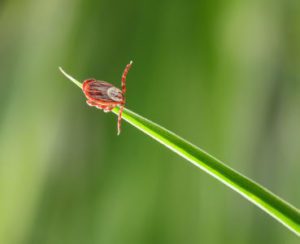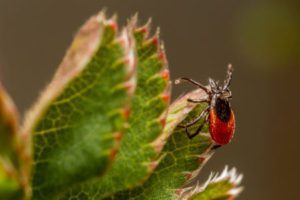AVOID TICKS DURING YOUR FAMILY “STAYCATION”
By Zachary Ciras on May 5, 2020.

American Dog Tick question at the end of a blade of grass. Shutterstock.
You probably haven’t been thinking about ticks yet this year, but there’s plenty of evidence that you should be. Most of us are spending more time outside (although with the required social distancing) either because we’re bored, our gym has closed, or we just figure we might as well start on all that neglected yard work.
And yes, ticks are active now and, in fact, have been for months (see Springtime Means Tick Time!). In our region in winter, ticks aren’t completely inactive but do spend their time hiding in leaf litter and yard debris waiting for warmer weather.
YARDS WITH A WOODS BORDER ARE AT HIGHER RISK
We know that our most important tick, the blacklegged tick that transmits Lyme disease, has more than one host animal. The little ticks (nymphs) feed on little animals like mice, and adult ticks prefer to feed on larger animals like deer. But any tick stage will feed on people or pets. Because their host animals tend to frequent wooded areas, in residential yards ticks are most common in the edge habitat where woods meets lawn.
We’ve written earlier blogs about how changes in landscaping, yard maintenance, and mowing can help reduce tick numbers (see Take Steps to Keep Ticks Out of Your Yard). Because much of your outside recreation and vacation in the time of coronavirus may be in your own backyard, you’ll want to pay more attention to keeping your yard pest-free this summer.
WHERE YOU LEAVE YOUR LEAVES AFFECTS TICK POPULATIONS
Piles of dried, fallen leaves are a known overwintering habitat for ticks and other arthropod pests, too. Yet, we faithfully rake them and pile them all along the perimeter of our yards as part of a fall ritual. It’s probably no surprise that a new research study in Monmouth NJ found that raking or blowing leaves just to the edge of the woods creates an ideal protective winter hiding place for blacklegged ticks.
The deeper leaf piles and the more humid conditions in the leaf litter resulted in a three-fold increase in the number of nymphal ticks in these sites the following spring. Your lovely leaf piles are allowing more ticks to survive right on the edge of your yard.
 Removing leaves from frequently-used areas of yard is still good advice to reduce tick numbers. Now, new recommendations for homeowners are to utilize curbside pickup of fall leaves, compost or mulch the leaves, or remove raked leaves to a location further into the woods or at least away from high use areas of your yard.
Removing leaves from frequently-used areas of yard is still good advice to reduce tick numbers. Now, new recommendations for homeowners are to utilize curbside pickup of fall leaves, compost or mulch the leaves, or remove raked leaves to a location further into the woods or at least away from high use areas of your yard.
For more on managing ticks on your property, see: